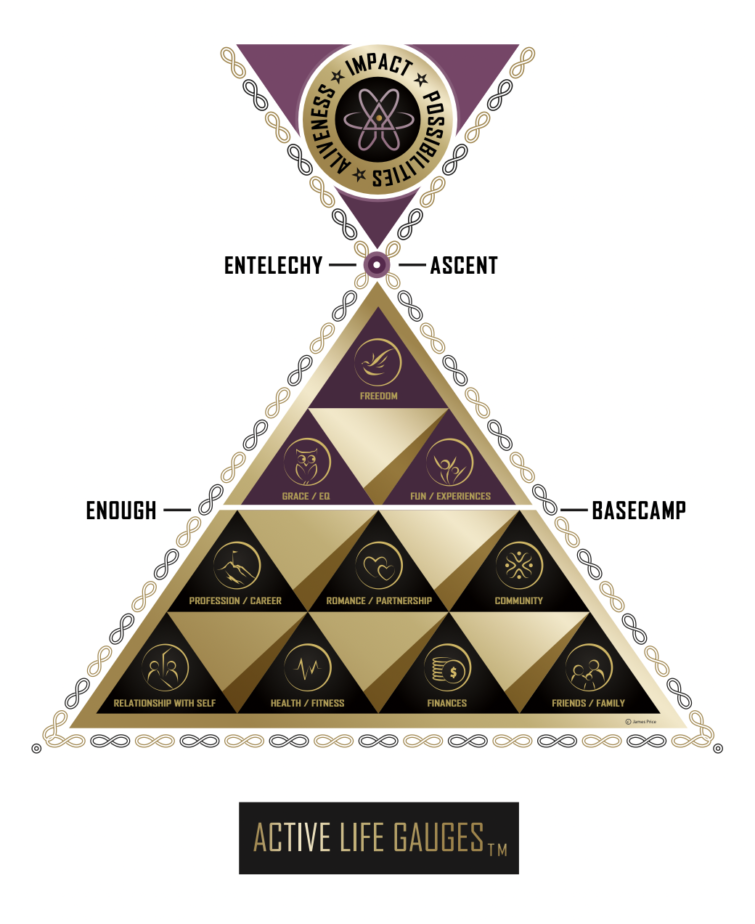Basecamp Terminology
1
Basecamp
Basecamp is a state of being. Living at Basecamp means your nervous system settles and you’re accessing your best self. It’s also the name of our 7-month program, designed to help live in that state of enoughness. Once we no longer lack in any area, we can point our life force at what matters most.
The Philosophy
Imagine life as an expedition up a huge Himalayan peak. You’ll have a higher chance of hitting the summit if you have a solid foundation to climb from. A place where you can comfortably rest and thrive between summit shots. That place is Basecamp. Our program is designed to get you there. When the foundational elements of your life are humming along, you’re living at Basecamp, ready for whatever’s next.
1
Relational Inquiry®
The process of authentic exploration through three levels of communication: informational, personal, and relational to create mutual understanding. The core principles of Relational Inquiry include: being with what is, questioning assumptions, understanding rather than changing, and creating a woven shared reality to create meaningful connections. Relational Inquiry® asks each of us to notice our inner state, the lens through which we see and experience the world.
Example: Relational Inquiry® involves open-hearted conversations and active listening to uncover deeper layers of understanding and empathy between friends.
“Relational Inquiry®” rooted in the principles of authentic relating, refers to the intentional and empathetic engagement in conversations and interactions with the purpose of establishing genuine connections and promoting personal development. This concept emphasizes the importance of active listening, vulnerability, and mutual respect as key components of exploring the intricacies of human relationships. Through relational inquiry, individuals or groups strive to uncover authentic insights, shared experiences, and underlying emotions, ultimately fostering a deeper sense of connection and enriching the quality of interpersonal interactions.
2
Active Life Gauges

Active Life Gauges represent core areas of life. As the above diagram indicates, there are 10 total life gauges, 7 of them we work with to get to Basecamp. Like Maslow’s hierarchy of needs, they are developmental. It is essential to reach a certain level of competence from the foundational (bottom) areas and work your way up. Most of the weight in a pyramid is on the bottom and decreases as we ascend. This design allowed ancient civilizations to create colossal and remarkably sturdy stone structures.
3
Entelechy
en·tel·e·chy
/ənˈteləkē/
The vital principle that guides the development and functioning of an organism, system, or organization.
Example: The entelechy of an acorn is to become an oak tree.
“Entelechy” is a philosophical and metaphysical concept that originated from ancient Greek philosophy, particularly associated with the philosopher Aristotle. It refers to the realization or fulfillment of potential inherent within a living organism or system, which leads to its self-development and actualization of its inherent purpose or essence. The term combines the Greek words “entelecheia” (meaning “having the end within itself”) and “telos” (meaning “end” or “purpose”).
Here’s a more thorough explanation of the concept of entelechy:
1. Aristotelian Background:
Aristotle, a renowned ancient Greek philosopher, introduced the concept of entelechy as a way to explain the nature of change and development in living organisms. He contrasted it with “dunamis,” which refers to potentiality or capacity. According to Aristotle, all living things possess both dunamis and entelechy. Dunamis is the potential for growth, change, and development that an organism inherently possesses. Entelechy, on the other hand, represents the realization or actualization of that potential, leading to the complete expression of an organism’s essential nature or purpose.
2. Self-Development and Purpose:
Entelechy suggests that living organisms have an inherent purpose or telos, a specific end goal that they naturally strive towards. This purpose is embedded within their very nature. For instance, the entelechy of an acorn is to become an oak tree; the entelechy of a caterpillar is to become a butterfly. Entelechy is the driving force behind an organism’s growth and development, guiding it towards fulfilling its unique potential.
3. Holistic Perspective:
The concept of entelechy emphasizes a holistic perspective on life and development. It implies that an organism is not merely a sum of its parts, but rather an integrated whole with an inner purpose. This holistic viewpoint contrasts with reductionist approaches that focus solely on isolated parts or mechanistic processes.
4. Continuous Unfolding:
Entelechy suggests that development is a continuous and ongoing process. It’s not a fixed endpoint but rather a dynamic realization of potential that unfolds over time. Each stage of development contributes to the eventual attainment of the organism’s telos.
5. Metaphysical Implications:
Entelechy has metaphysical implications, raising questions about the nature of life, purpose, and existence. It challenges mechanistic views of the universe by emphasizing that living organisms possess an inherent striving towards fulfillment. This concept has been influential in discussions about vitalism (the belief in a unique life force) and teleology (the study of purpose in nature).
6. Modern Interpretations:
While the term “entelechy” has its roots in ancient philosophy, it has found resonance in modern discussions about emergence, self-organization, and complexity theory. These ideas explore how systems exhibit emergent properties and behaviors that are not directly reducible to the interactions of their individual components.
In summary, “entelechy” is a profound philosophical concept that highlights the inherent potential and purpose within living organisms. It encapsulates the idea that development is driven by an internal force guiding an organism towards the fulfillment of its unique nature. This concept has implications for how we perceive life, purpose, and the interconnectedness of all living things.